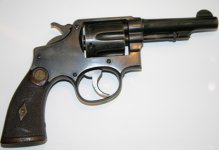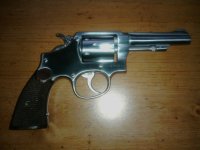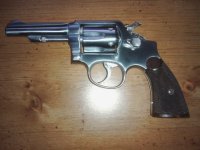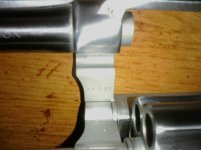I am looking for information on a very old 38 S&W Special CTG with matching SN 297475 on butt, cylinder and barrel. Walnut checkered grips with S&W logo, round butt. No logo on either side of the receiver. No numbers in the crane.
Barrel Markings: Smith & Wesson Springfield Mass USA
Patented October 8, 1901. Dec. 17, 1901.
Feb. 8, 1906. Sept. 14, 1909. Dec. 29, 1914.
4” barrel. Fixed half-moon front sight. Action is good with a clean bore and cylinder locks tight. Blued finish I'm guessing perhaps 75%. Attached is a picture.
Any info would be appreciated...age, history, value. Thanks !!
Barrel Markings: Smith & Wesson Springfield Mass USA
Patented October 8, 1901. Dec. 17, 1901.
Feb. 8, 1906. Sept. 14, 1909. Dec. 29, 1914.
4” barrel. Fixed half-moon front sight. Action is good with a clean bore and cylinder locks tight. Blued finish I'm guessing perhaps 75%. Attached is a picture.
Any info would be appreciated...age, history, value. Thanks !!




